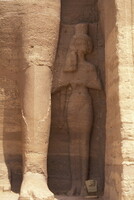Small Temple of Abu Simbel
unknown (Egyptian (ancient))

Download1A3-EG-AS-2-D8_cp.jpg (466.9Kb)
Alternative Title
Abu Simbel; Temple of Hathor
Date
-1279--1250Description
Detail showing one of the children at the feet of a colossus; Abu Simbel is a site in Egypt, on the west bank of the Nile in Lower Nubia, 280 km south of Aswan. With the construction of the Aswan Dam in the early 1960s, the temple complex was one of a number of ancient monuments saved by being moved to a new site. Having been cut into pieces and reassembled, it now stands on the shores of Lake Nasser, 64 m higher and 180 m west of its ancient site. It was already an ancient sacred site when Ramesses II (reigned ca. 1279-ca. 1213 BCE) chose it for his most grandiose, and most famous, Nubian monument. The construction of the Great and Small Temples of Abu Simbel began in the early years of Ramesses II, and they were completed by around the 25th year of his reign. The façade of the Small Temple is dominated by six colossi (h. 10 m), four of Ramesses II and two of his chief wife Nefertari, to whom the temple is dedicated. Smaller statues of the royal children (princes with the King, princesses with the Queen) flank the larger ones. The doorway leads into a square hall supported by six square piers. The sides of the piers facing inwards towards the aisle have been carved into the form of sistra with heads of the goddess Hathor. The entrance hall is decorated with two scenes of Ramesses II smiting his enemies, accompanied by Nefertari. Nefertari in this temple was identified with a local form of the goddess Hathor. Source: Grove Art Online; http://www.groveart.com/ (accessed 1/15/2008)
Type of Work
temple; excavation (site)Subject
architectural exteriors, deities, rulers and leaders, Ramses II, King of Egypt, New Kingdom (Egyptian), Nineteenth Dynasty, Ramesside period
Rights
Rights Statement
Licensed for educational and research use by the MIT community only